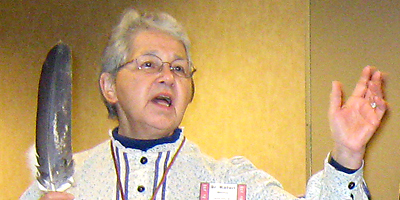
 GREENVILLE—The opportunities for women in the Catholic Church have never been greater, according to Sister Pamela Smith, SSCM.
GREENVILLE—The opportunities for women in the Catholic Church have never been greater, according to Sister Pamela Smith, SSCM.
The Director of the Office of Catechesis and Christian Initiation delivered that message at the Diocese of Charleston’s first “Women’s Gathering” held Nov. 20 at the Hyatt Hotel.
“We need to recognize the power that we have,” Sister Pamela said. “Women have had a tremendous history in the history of the Catholic Church and have made tremendous contributions,” she said.
It’s a history that dates to Ruth, Judith and Ester in the Old Testament and to Mary and Elizabeth in the New Testament, some of whom are the subjects of books written by Sister Pamela.
“Ruth is a direct ancestor of David and Solomon and Jesus. She is a Moabite woman who is a turning point of Old Testament history,” she said.
In the New Testament, Mary played that same role, the Sister of Sts. Cyril and Methodius said, adding that there are accounts in Acts of the Apostles where Jewish women follow Paul during his ministry.
“One thing that’s very much a part of [women’s] history, not always highlighted in a homily but clearly there when we look at Scripture, is a strong sense of women as turning points in church history,” Sister Pamela said.
That feminine tradition has continued into the modern church, which has maintained its long custom of honoring holy people — many of them women.
“We have men and women, equally represented, who have truly followed Christ,” Sister Pamela said.
Victoria Norris, who said she is a cradle Catholic and parishioner at Our Lady of the Rosary Church in Greenville, noted the increased role women are playing in the church, particularly during the celebration of Mass.
“Women are much more involved in the preparation for Mass, being a part of the Mass, and young girls are serving as altar ministers,” Norris said. “There was none of that when I was growing up.”
The SCCCW Piedmont Deanery and the Diocese of Charleston Office of Ethnic Ministries sponsored the event. It was funded by a grant from the Black and Indian Mission-Native American Evangelization. Nearly 50 women attended, primarily from the deanery affiliates which include groups from St. Anthony of Padua and St. Mary churches in Greenville, and St. Paul the Apostle Church in Spartanburg.
Sister Kateri Mitchell, executive director of the Tekakwitha Conference in Great Falls, Mont., served as spiritual leader for the gathering.
She is a Sister of St. Anne and was on the International St. Regis Mohawk Reservation that includes Upstate New York, southern Ontario and Quebec. She belongs to a matriarchal and matrilineal society of the Iroquois Confederacy.
The conference started among Native Americans in the Dakotas in 1939 as a missionary group. Thirty years later, it grew to include non-clergy members — women, deacons and some non-native women religious.
Sister Kateri said she attended her first conference in South Dakota in 1979. The following year, they attempted to broaden its reach by holding the first conference outside of the Dakotas. Since then, conferences have been held annually in more than a dozen states and in Canada.
Sister Kateri said the national event represents nearly half a million Native American Catholics from more than 300 tribes. She said there aren’t many from South Carolina who are members of the conference currently, although representation is larger in neighboring North Carolina.
“We are hoping that it will grow here,” Sister Kateri said.
Norris married into the Cherokee Nation and works with her husband in caring for more than three acres of tribal land located near Gray Court, south of Greenville.
She said approximately 40,000 Native Americans live in South Carolina spread among 10 tribes.
Norris’ husband joined the Catholic Church three years ago, and she’s thrilled with the opportunity to learn more about Native American Catholics, she said.
“We, as a tribe, are very excited about it,” Norris said. “We’re happy that our bishop recognizes our need to know how we can be Cherokee and Catholic.”
